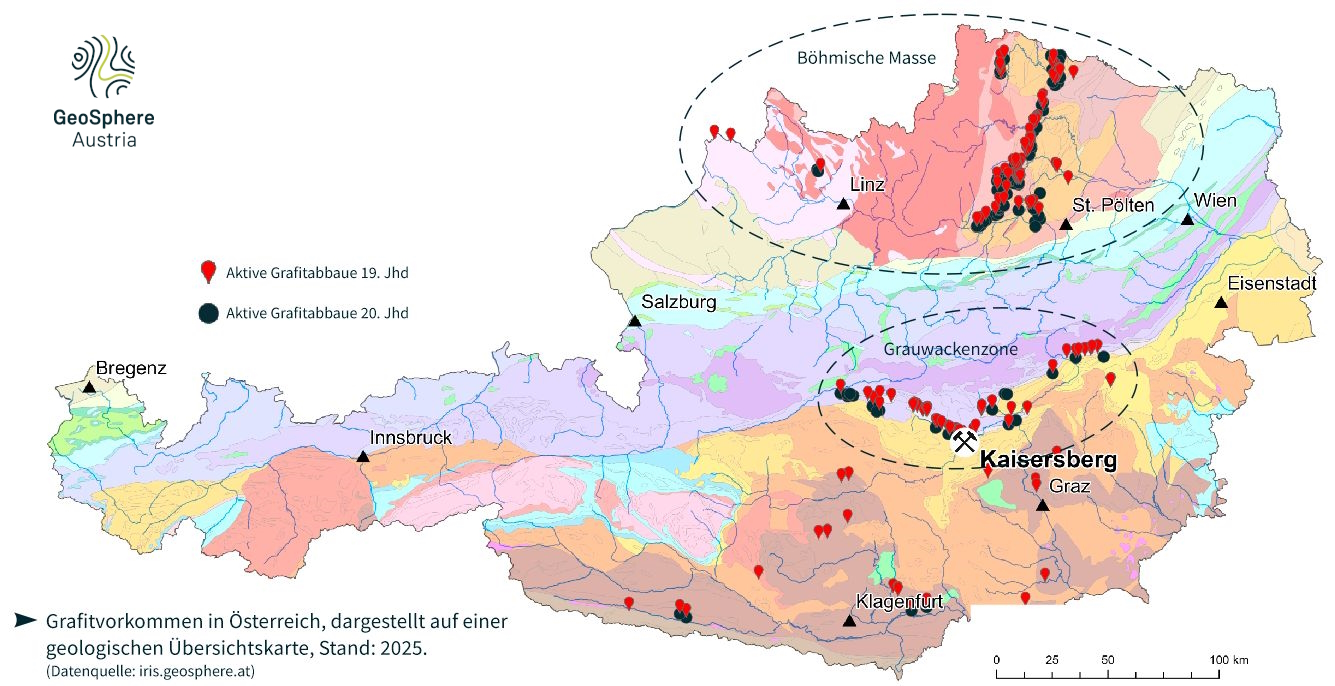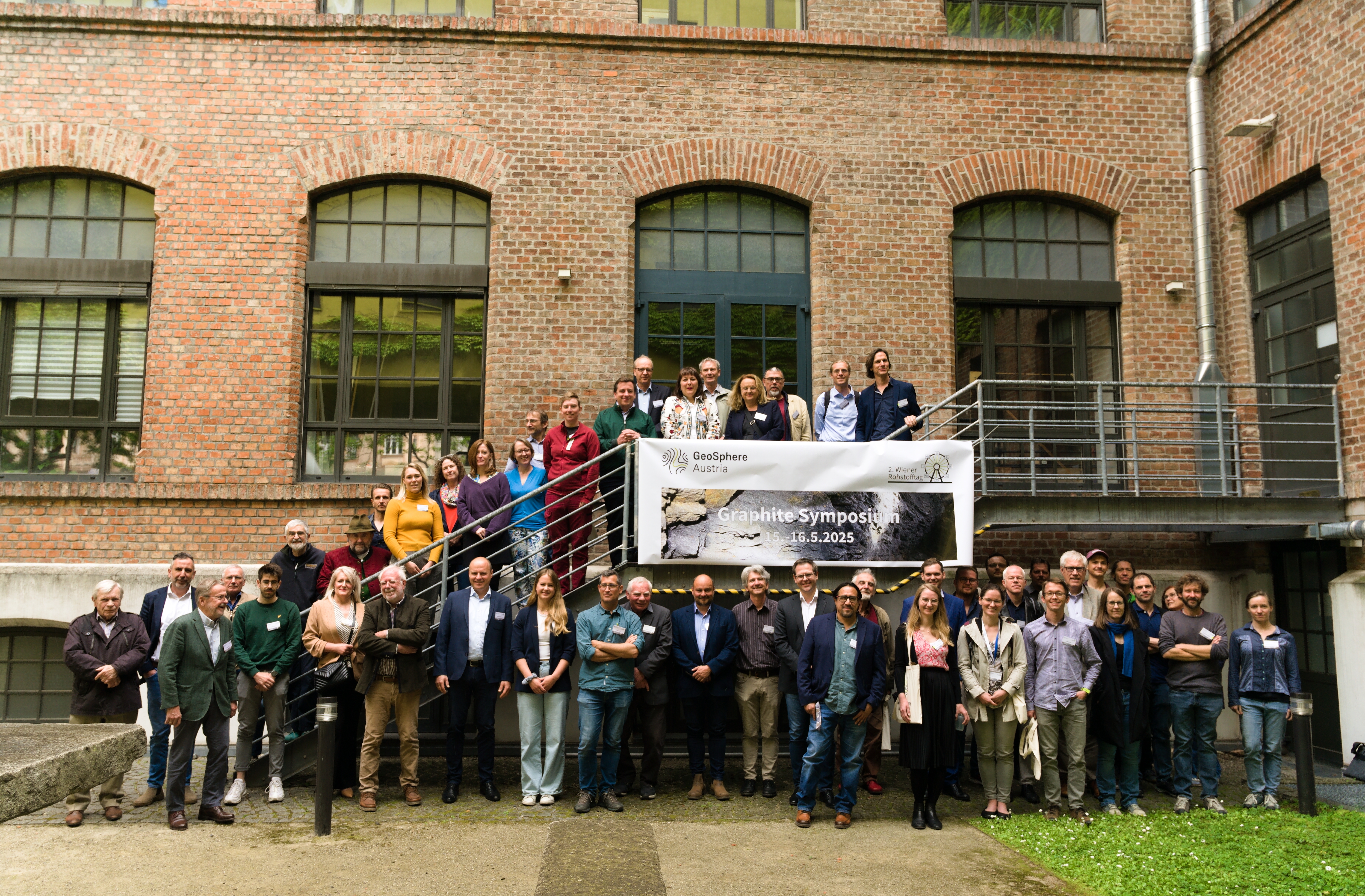Critical raw material graphite: international conference in Vienna
The demand for graphite is increasing worldwide. Among other things, graphite is an important component of lithium-ion batteries for e-mobility and has been categorised as a critical raw material by the EU. GeoSphere Austria is using geological and geophysical methods to assess graphite deposits in Austria. From 15 to 16 May 2025, GeoSphere Austria is organising the ‘2. Wiener Rohstofftag’ on the topic of graphite, with around 50 participants from nine countries.
Natural and synthetic graphite play a major role in the international raw materials market: Natural graphite consists of pure carbon and was formed in a process lasting several million years from organic, carbonaceous material (e.g. algae, humus, digested sludge) in the course of mountain formation (graphite is converted into diamond under very high pressures when it reaches depths of less than 250 kilometres in the earth's crust). Synthetic graphite is produced from by-products of the petroleum and coal industries.
Its special properties make graphite an indispensable raw material in many areas:
- High oxidation and temperature resistance: applications in the high-temperature range (e.g. metal processing, foundry and refractory industry)
- Excellent electrical conductivity: anode material in lithium-ion batteries and in the electronics industry
- Good lubricity: additive in lubricants for bearings and seals
- Easy to mould: production of various moulds (e.g. for foundries)
- Graphite-reinforced plastic ‘carbon’: more stability and lightness, for example in sports equipment (e.g. skis, golf clubs, bicycle frames)
- Also used in clutches and brake linings, as graphite rods in nuclear reactors, in plasterboard and for pencils
China currently has the largest share of global graphite production with 67 per cent, followed by Mozambique with 10 per cent. Austria is one of the few European countries with graphite mining (100 tonnes per year), but with a share of 0.01 per cent, it only ranks 17th in global production. Graphite mining flourished in Austria in the 1960s with around 100,000 tonnes per year.
Europe mainly covers its growing demand for graphite with imports. The European Union has therefore categorised graphite as a critical raw material due to the supply risk and its great economic importance.
The ‘European Regulation on Critical Raw Materials’ adopted by the EU in March 2024 set, among other things, the target that at least ten per cent of consumption should come from European extraction in the long term. The individual countries are therefore called upon to analyse their graphite deposits.
Austria's graphite deposits are mainly located in the greywacke zone between Semmering and Rottenmann and in the Bohemian Massif of the Mühlviertel and Waldviertel.
Many of the known graphite deposits near the surface in Austria have been largely mined out. This is why there is particular interest in possible deposits in deeper layers (between around 50 and 300 metres).
‘The potential for graphite deposits can be characterised by scientific investigations,’ explains Holger Paulick, Head of the Department of Resource Geology and Geoenergy at GeoSphere Austria, ‘we therefore determine possible deposits using a combination of different methods, such as geological mapping, geochemical rock analyses and special geophysical methods, which, for example, allow conclusions to be drawn about the nature of the subsurface via the electrical and magnetic properties of the rock.’
The current investigations are focussed on the Lower Austrian part of the Bohemian Massif. Different exploration methods for graphite are being researched and potential storage areas are being narrowed down. For better international comparability, the deposits are being classified for the first time according to the UNFC Code of the United Nations
From 15 to 16 May 2025, around 50 experts from nine European countries will meet to exchange experiences at the ‘2. Wiener Rohstofftag’, organised by GeoSphere Austria. ‘This year's conference will cover various aspects of graphite. We want to create a forum for the different areas involved in the topic,‘ says Holger Paulick, ’for research institutions, geological organisations and professional associations as well as industry and authorities. The focus here is on geoscientific research, current developments and methods of finding deposits as well as political, economic and socio-geographical framework conditions.‘
GeoSphere Austria is also holding a small exhibition on the raw material graphite, with text panels and graphite products, at Neulinggasse 38 in 1030 Vienna until the end of July 2025. Also on display here is a sculpture made of graphite, which was exhibited at the 1873 World Exhibition in Vienna in the pavilion of Prince Schwarzenberg, and was subsequently added to the collection of the Imperial and Royal Geological Survey, a predecessor organisation of GeoSphere Austria, as a gift.
Translated with DeepL.com (free version)



